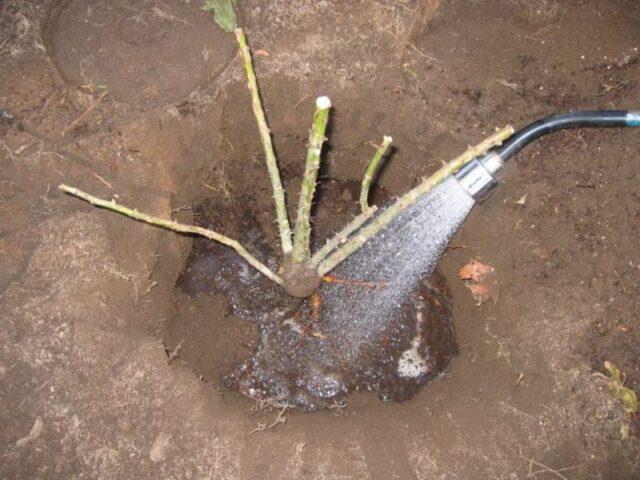Content
- 1 Is it possible to grow rose hips from berries?
- 2 Is it possible to grow rose hips at home?
- 3 When can you plant rose hips?
- 4 Conditions for growing rose hips
- 5 How to grow rose hips from fruits
- 6 How to grow rose hips on a trunk
- 7 How to grow rose hips at home
- 8 How to plant rose hips in spring
- 9 How to plant rose hips in summer
- 10 How to properly plant a rosehip bush in the fall
- 11 How to plant rose hips along a fence
- 12 How to care for rose hips
- 13 Conclusion
You can plant rose hips in your dacha to obtain useful fruits or for decorative purposes. In both cases, it is necessary to study the rules of growing the crop.
Is it possible to grow rose hips from berries?
You can grow rose hips not only from ready-made seedlings, but also from seeds in berries. You need to collect material for planting from mature plants that are about 4-6 years old. In this case, it is best to store seeds from slightly unripe berries - the shell of the seeds in them has not yet had time to properly harden, and it is easier to germinate the crop.
Is it possible to grow rose hips at home?
Rose hips can be grown in an apartment, although planting and caring for the plant are associated with certain difficulties. The culture grows well in small pots and pleases with beautiful flowering. But since the home bush cannot grow abundantly, its fruiting is also in question.

Rose hips should be grown in an apartment for decorative purposes.
When can you plant rose hips?
Rose hips take root well and quickly in the ground throughout the warm season. But it is best to plant before the active growing season begins or after it ends.
When is it better to plant rose hips - in spring or autumn?
If necessary, rose hips can be planted on the site in early spring. But it is better to do this in the fall, in which case the plant will take root faster.
When to plant rose hips in the fall, in what month
It is recommended to plant rose hips in October or early November, shortly before frost. When growing shrubs in Siberia or the Urals, the timing can be shifted to the beginning of autumn, since cold weather occurs earlier in these regions.
When to plant rosehip seedlings
Rosehip seeds harvested at the end of summer must first be dried from moisture and then stored in the refrigerator in moistened sand for six months. Long-term stratification increases the germination of the material and the endurance of future plants.
Correctly, remove the seeds from the refrigerator in early March. Planting material is soaked in warm water and then sown into the soil.
Conditions for growing rose hips
Most rosehip varieties have good hardiness and do not have strict planting requirements. But it is still necessary to pay attention to the choice of location and soil.
Where is the best place to plant rose hips in a summer cottage?
It is recommended to place rose hips on hills and well-lit areas. The plant tolerates planting in partial shade, but it is important to choose a place for it away from groundwater. The roots of the bush penetrate deep into the ground and can rot in wetlands.
Soil requirements
Rose hips can be planted on almost any soil. The main thing is that the soil is not too acidic; in such conditions the bush will develop slowly and may become sick. The optimal pH for the crop is about 6.0; if necessary, the soil is limed to the desired state before planting.
Is it possible to plant roses and rosehips next to each other?
Rose hips are closely related to roses, but are more aggressive by nature. When planted next to an ornamental crop, it will suppress it and interfere with its development.
How to grow rose hips from fruits
To grow rose hips in the country from seeds, you need to learn the rules for breeding the crop. Overall the algorithm is quite simple:
- After harvesting in mid- or late August, the seeds of the plant are removed from the berries, washed to remove any remaining pulp and lightly dried. Throughout the fall and winter, the material in wet sand is removed to a dark and cold place for stratification.
- In March, before planting, the container with the seeds is removed and the seeds are soaked for 12 hours in warm water. Shallow pots or wide boxes are filled with a mixture of garden soil, sand and peat in equal parts and superphosphate and potassium chloride are added - 30 g per 10 liters of soil.
- Seeds are planted in rows to a depth of about 2 cm, leaving 1.5 cm between individual seedlings. The grooves are sprinkled with soil and moistened generously with a spray bottle, and then covered with film.
- Over the course of a month, the seeds are germinated in a warm place with diffused lighting, ventilating and moistening from time to time. After the seedlings emerge, the shelter is removed and the container is placed on a sunny windowsill.
In the future, the seedlings continue to be regularly moistened and fed with potassium minerals every two weeks. Seedlings are transferred to the ground at the end of May or in October.

After a pair of true leaves appear, rosehip seedlings are planted in separate containers
How to grow rose hips on a trunk
The standard forms of rose hips look very impressive, and at the same time you can grow them yourself without buying a ready-made tree from a nursery. The algorithm looks like this:
- Seeds are extracted from the ripe fruits of an adult plant, stratified in the classical way in the refrigerator until spring and sown at the end of March or in April. In the fall, the strongest and hardiest shoots are selected and planted in the soil, after which they are grown for two years.
- In the third year, the selected plants are carefully dug up and all shoots except the thickest and straightest are removed from the root collar. The side branches are shortened to 20 cm. Future trunks are transferred to a trench or stored in a cold cellar until spring.
- With the onset of the new season, the rose hips are removed, their roots are examined and frozen and broken parts are removed, after which they are planted in a permanent place with the root collar deepened by 2 cm. A peg is installed nearby, to which the trunk is tied in several places.
- At the end of July, the thorns around the eye are broken off on the selected shoot of a varietal rose hip or decorative rose.From the leaf adjacent to the bud, leave a cutting about 2 cm long.
- Using a sharp knife, the eye is separated from the shoot, and a T-shaped cut is made on the rootstock. The graft is inserted into the made “pocket” and pressed with bark, and then the graft is secured with a bandage so that the cutting and the bud remain outside.

The bandage from the graft is removed after the graft begins to grow - this will mean that it has taken root
If the procedure is carried out correctly, engraftment should take 2-4 weeks.
How to grow rose hips at home
When planting at home, it is not always possible to get rose hips to bear fruit. But it blooms beautifully, so in any case it is popular as a houseplant.
The rosehip planting scheme is quite simple:
- Seeds harvested at the end of summer are washed with water, dried and placed in moistened sand in the refrigerator for several months. From time to time, the substrate needs to be stirred and liquid added as it evaporates.
- At the beginning of spring, small pots are filled with a mixture of leaf soil, peat and compost in equal proportions, and a little sand, wood ash and superphosphate are also added. The seeds are removed from the refrigerator, soaked for 12 hours and buried 2 cm in separate containers, after which they are sprinkled with soil.
- After planting, seedlings are sprayed generously with water, covered with film and stored for a month in a warm place with dim lighting. When the first shoots appear, the shelter is removed and the pots are placed on the warmest and sunniest windowsill. As the soil dries, the seedlings are watered with settled, lukewarm water.
- As the culture grows, it is planted in new pots - each time they should be a little larger than the previous ones.Plants should not be planted in containers that are too wide; in this case, the soil will turn sour.
To grow rose hips at home, you need to fertilize them from the second year of life before flowering, at the beginning of the decorative period and in mid-summer. You can use complex minerals, as well as an infusion of chicken manure. Fertilizers significantly increase the likelihood that rose hips will bear fruit in indoor conditions.

As the home rose hips grow, they need to be pruned - this improves flowering
With the onset of winter, when planting at home, the plant is moved away from hot radiators so that the foliage does not dry out and get burned. Stop fertilizing and water the bush only once a month.
How to plant rose hips in spring
Planting rosehip seedlings in spring generally follows a standard algorithm. You just need to prepare a place for the bush in advance and not miss the optimal timing:
- In the autumn of the previous season, the area chosen for the crop is dug up and, if necessary, the soil is limed. To enrich the soil, it is recommended to add rotted manure and compost to it.
- After the soil thaws in the spring, but before buds form, at the end of March or beginning of April, a hole of about 50x50 cm is dug in the area. A layer of drainage is laid at the bottom, and then the hole is filled halfway with a mixture of garden soil, peat and compost.
- A rosehip seedling, previously soaked in water for two hours, is lowered into the hole and the roots are spread along the sides of the mound. From above, the plant is covered with the remains of the soil level with the surface.
Immediately after planting, the rose hips are watered abundantly.When rooting several bushes at once, leave 1-1.5 m of space between them.

In order for a rosehip seedling to take root faster during spring planting, its shoots are cut to 10-15 cm
How to plant rose hips in summer
The hardy rosehip is able to successfully take root in the area even when planted in summer. But when carrying it out, it is important to take into account some nuances:
- A couple of weeks before transferring the plant to the ground, prepare a hole about half a meter deep, fill it halfway with soil and add potassium and phosphorus mineral fertilizers. The purchased seedling is soaked in water for several hours so that its roots are properly saturated with moisture.
- According to the standard algorithm, the rose hips are lowered into the hole and covered with soil until the end. Immediately after this, the plant is watered with 3-4 buckets of settled, heated liquid. The soil at the roots is immediately mulched with straw or dry grass so that the moisture evaporates as slowly as possible.
- Shading is installed over the young summer seedling - a mesh or thin white material is stretched. The scorching sun can seriously damage the plant.
It will be possible to remove the protective canopy only after fresh foliage begins to appear on the rose hips.

When planting in summer, rose hips can be additionally watered before filling the hole with soil.
How to properly plant a rosehip bush in the fall
The period from October to November is considered the most successful time for planting rose hips. The shrub, which has already entered a dormant state, easily takes root in the soil and manages to adapt to a new place even before the coldest weather:
- Shortly before planting, a hole about 50 cm deep is dug in the area; it needs to be twice the size of the root system. A mixture of ordinary garden soil, rotted manure and compost is poured into the hole up to the middle.
- Before planting, young rose hips are pruned so that the length of thick branches does not exceed 10 cm. The roots of the plant can also be shortened to 20 cm.
- The seedling is briefly immersed in a “chatterbox” made from clay diluted with water. Then the plant is lowered into the hole and the roots are straightened, after which it is completely covered with earth.
The rosehip is watered with 3-4 buckets of water and the tree trunk is sprinkled with sawdust or dry peat. After the onset of the first cold weather, the plant is carefully insulated with a layer of mulch of about 10 cm and covered with non-woven material on top.

During autumn planting, the rosehip neck is buried 5-8 cm below the soil surface
How to plant rose hips along a fence
When planting and caring for rose hips in the Moscow region and other regions, the plant is often used to form a flowering hedge along a regular fence. The bushes need to be arranged according to a special algorithm, so that as they grow they turn into a dense but neat green wall:
- Before planting, the area is carefully marked - a rope is pulled according to the outlines of the future fence, retreating approximately 50 cm from the fence. Holes are dug in the ground at a distance of about 40-60 cm from each other. To make the bushes take root faster, you can add a glass of superphosphate and 50 g of potassium sulfate to each of the holes.
- The underground part of the seedlings is cut to 15-20 cm and briefly soaked in a clay solution with an added growth stimulator. After this, the bushes are lowered into prepared holes, half covered with earth.Root collars are deepened to 6 cm.
- Planted plants are moistened abundantly, pouring at least a bucket of water under each specimen. On the front side of the future fence, a restriction is immediately installed from corrugated sheets, old slate or other material, deepening the border to 50 cm. This will prevent the development of root growth.
For the winter, young plants are insulated and covered, and with the onset of spring they are cared for according to the standard algorithm. As the planting progresses, it will need to be trimmed; to simplify the procedure, you can also use markings made from a stretched rope.

Rose hips planted near the fence not only decorate the fence, but also protect the area from animals
How to care for rose hips
After planting, the unpretentious rosehip requires the gardener to follow the most basic rules. It is important to moisten the plant, feed it and prune it on time.
When and how to water
When growing rose hips in the garden and caring for them, it is necessary to water the plant as the soil in the tree trunk dries. The soil should remain slightly moist, but it is important to avoid waterlogging.
For plants two years old and older, watering can be carried out up to 3-4 times a season in the absence of severe drought. Each time, 2-3 buckets of settled water are added under the bush.
How to fertilize
Planting and caring for rose hips in open ground includes regular nitrogen fertilizing; they begin to be applied from the second year of the plant’s life. Fertilizers are added for the first time in early spring, then in June-July during the development of stems, and finally in August or September.
When and how to prune
Rose hips require the first pruning 2-3 years after planting.In order for the plant to produce good yields, it is recommended to leave 15-20 branches on each bush. It is desirable that all shoots be of different ages, but not older than seven years.
If the plant can be trimmed as the crown thickens, then sanitary pruning is carried out annually in early spring. In the process, all weak and diseased shoots, as well as branches growing inside the bush, are removed.
Disease and pest control
Planting and caring for garden rose hips is rarely complicated by the fight against fungi and insects. But the danger to culture still poses:
- powdery mildew - the leaves and shoots of the plant become covered with a whitish coating, which in the first stages is easy to remove with your fingers;
Powdery mildew interferes with photosynthesis in the leaves, causing the leaves to wither and fall off.
- black spot - in the second half of summer, dark brown marks appear on the leaves and petioles;
Black spotting is characterized by uneven, star-shaped markings.
- rust - the leaf blades become covered with yellow-orange pads; as the disease develops, the rosehip dries out.
- Rust affects not only the leaves, but also the shoots of rose hips
Rust affects not only the leaves, but also the shoots of rose hips
In the fight against rose hip fungi, you can use copper preparations, Bordeaux mixture, as well as Fundazol, Strobi and Abiga-Peak. Spraying is carried out several times a season at intervals of 2-3 weeks.
Among the pests, the following insects can damage rose hips:
- sawflies - pest larvae eat leaves and make passages inside the young shoots of the plant;
In case of slight sawfly infestation, caterpillars from leaves can be collected manually
- leaf rollers - caterpillars feed on young leaves and shoots and greatly damage the green mass of the bush;
It is easy to recognize the leaf roller by the characteristic deformation of the leaf plates
- spider mite - an insect that entangles shoots and leaves with a thin web, feeds on plant sap and also suffers incurable viral diseases.
Spider mites grow on rose hips in dry weather
If the pest infestation is weak, you can fight them using a regular soap solution. If insects have managed to seriously damage the plant, it is worth using acaricides and insecticides - Aktara, Aktellik and other means.
Preparing for winter
Most varieties of rose hips tolerate winter cold well. But the bush still needs shelter, especially for young seedlings.
Before the onset of cold weather, rosehip roots are densely mulched with peat, sawdust and fallen leaves. The thickness of the layer should be at least 10 cm. Low and compact bushes are additionally wrapped with non-woven material along the crown to protect sensitive branches from freezing and damage.
Conclusion
Rose hips can be planted throughout the season, from spring to late autumn. The shrub has few maintenance requirements and requires moderate watering and regular feeding. Decorative varieties need to be pruned from time to time to maintain their shape.


 Rust affects not only the leaves, but also the shoots of rose hips
Rust affects not only the leaves, but also the shoots of rose hips










